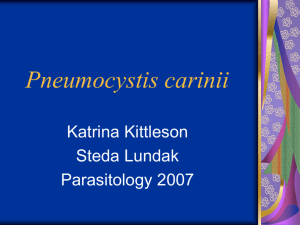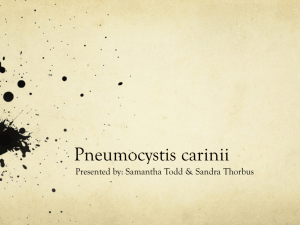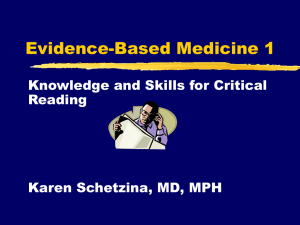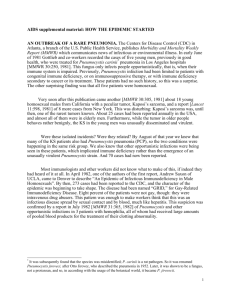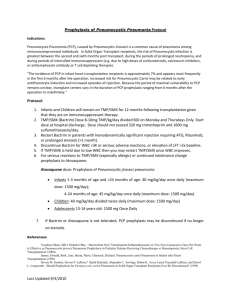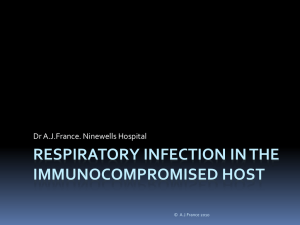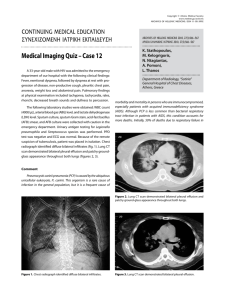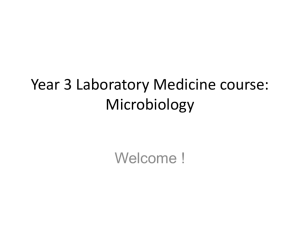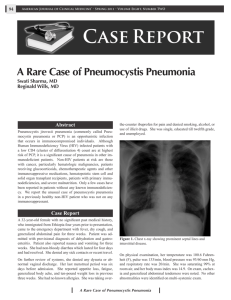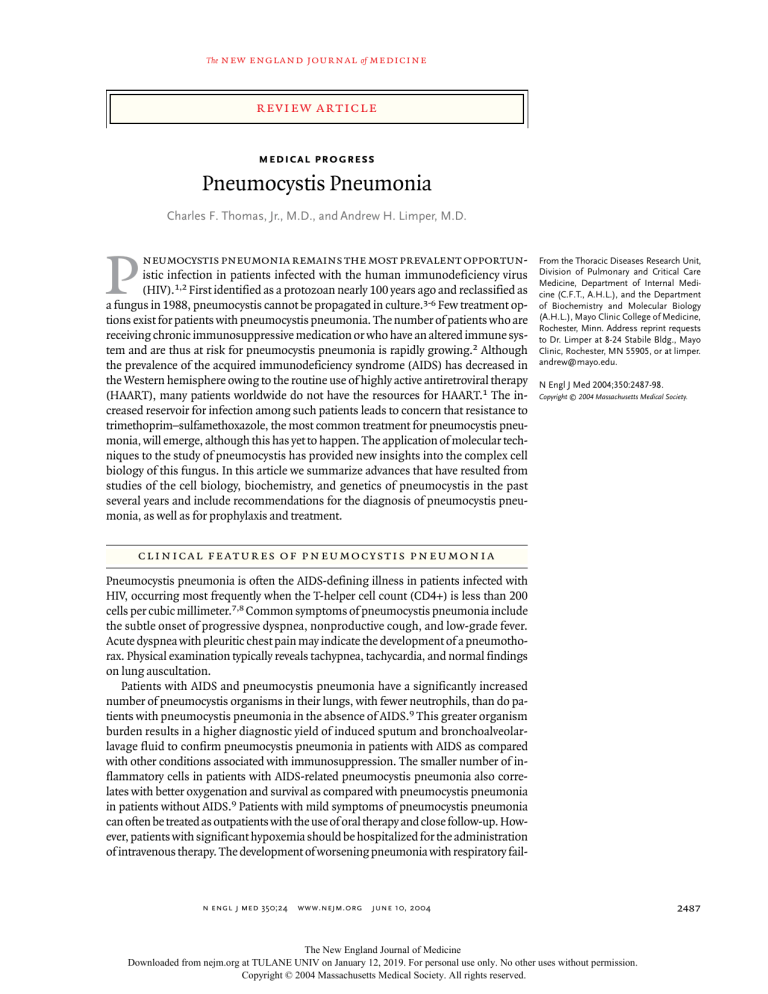
The new england journal of medicine review article medical progress Pneumocystis Pneumonia Charles F. Thomas, Jr., M.D., and Andrew H. Limper, M.D. neumocystis pneumonia remains the most prevalent opportunistic infection in patients infected with the human immunodeficiency virus (HIV).1,2 First identified as a protozoan nearly 100 years ago and reclassified as a fungus in 1988, pneumocystis cannot be propagated in culture.3-6 Few treatment options exist for patients with pneumocystis pneumonia. The number of patients who are receiving chronic immunosuppressive medication or who have an altered immune system and are thus at risk for pneumocystis pneumonia is rapidly growing.2 Although the prevalence of the acquired immunodeficiency syndrome (AIDS) has decreased in the Western hemisphere owing to the routine use of highly active antiretroviral therapy (HAART), many patients worldwide do not have the resources for HAART.1 The increased reservoir for infection among such patients leads to concern that resistance to trimethoprim–sulfamethoxazole, the most common treatment for pneumocystis pneumonia, will emerge, although this has yet to happen. The application of molecular techniques to the study of pneumocystis has provided new insights into the complex cell biology of this fungus. In this article we summarize advances that have resulted from studies of the cell biology, biochemistry, and genetics of pneumocystis in the past several years and include recommendations for the diagnosis of pneumocystis pneumonia, as well as for prophylaxis and treatment. p From the Thoracic Diseases Research Unit, Division of Pulmonary and Critical Care Medicine, Department of Internal Medicine (C.F.T., A.H.L.), and the Department of Biochemistry and Molecular Biology (A.H.L.), Mayo Clinic College of Medicine, Rochester, Minn. Address reprint requests to Dr. Limper at 8-24 Stabile Bldg., Mayo Clinic, Rochester, MN 55905, or at limper. andrew@mayo.edu. N Engl J Med 2004;350:2487-98. Copyright © 2004 Massachusetts Medical Society. clinical features of pneumocy stis pneumonia Pneumocystis pneumonia is often the AIDS-defining illness in patients infected with HIV, occurring most frequently when the T-helper cell count (CD4+) is less than 200 cells per cubic millimeter.7,8 Common symptoms of pneumocystis pneumonia include the subtle onset of progressive dyspnea, nonproductive cough, and low-grade fever. Acute dyspnea with pleuritic chest pain may indicate the development of a pneumothorax. Physical examination typically reveals tachypnea, tachycardia, and normal findings on lung auscultation. Patients with AIDS and pneumocystis pneumonia have a significantly increased number of pneumocystis organisms in their lungs, with fewer neutrophils, than do patients with pneumocystis pneumonia in the absence of AIDS.9 This greater organism burden results in a higher diagnostic yield of induced sputum and bronchoalveolarlavage fluid to confirm pneumocystis pneumonia in patients with AIDS as compared with other conditions associated with immunosuppression. The smaller number of inflammatory cells in patients with AIDS-related pneumocystis pneumonia also correlates with better oxygenation and survival as compared with pneumocystis pneumonia in patients without AIDS.9 Patients with mild symptoms of pneumocystis pneumonia can often be treated as outpatients with the use of oral therapy and close follow-up. However, patients with significant hypoxemia should be hospitalized for the administration of intravenous therapy. The development of worsening pneumonia with respiratory fail- n engl j med 350;24 www.nejm.org june 10, 2004 The New England Journal of Medicine Downloaded from nejm.org at TULANE UNIV on January 12, 2019. For personal use only. No other uses without permission. Copyright © 2004 Massachusetts Medical Society. All rights reserved. 2487 The new england journal ure in these patients is the most common reason for admission to an intensive care unit. Among most patients with AIDS and pneumocystis pneumonia, the mortality rate is 10 to 20 percent during the initial infection, but the rate increases substantially with the need for mechanical ventilation.10 Patients who have pneumocystis pneumonia without AIDS typically present with an abrupt onset of respiratory insufficiency that may correlate with a tapered or increased dosage of immunosuppressant medications.11,12 Affected patients have more neutrophils and fewer pneumocystis organisms in their lungs during an episode of pneumocystis pneumonia than do patients with AIDS who have pneumocystis pneumonia.9 The mortality rate among patients with pneumocystis pneumonia in the absence of AIDS is 30 to 60 percent, depending on the population at risk, with a greater risk of death among patients with cancer than among patients undergoing transplantation or those with connective-tissue disease.2,13 Typical radiographic features of pneumocystis pneumonia are bilateral perihilar interstitial infiltrates that become increasingly homogeneous and diffuse as the disease progresses (Fig. 1).14 Less common findings include solitary or multiple nodules, upper-lobe infiltrates in patients receiving aerosolized pentamidine, pneumatoceles, and pneumothorax. Pleural effusions and thoracic lymphadenopathy are rare. When chest radiographic findings are normal, high-resolution computed tomography, which is more sensitive than chest radiography, may reveal extensive groundglass attenuation or cystic lesions.15 diagnosis of pneumocy stis infection of medicine the initial procedure used to diagnose pneumocystis pneumonia, particularly in patients with AIDS.17 If the initial specimen of induced sputum is negative for pneumocystis, then bronchoscopy with bronchoalveolar lavage should be performed. Transbronchoscopic or surgical lung biopsy is rarely needed.18 Trophic forms can be detected with modified Papanicolaou, Wright–Giemsa, or Gram– Weigert stains. Cysts can be stained with Gomori methenamine silver, cresyl echt violet, toluidine blue O, or calcofluor white. Monoclonal antibodies for detecting pneumocystis have a higher sensitivity and specificity in induced-sputum samples than conventional tinctorial stains have, but the difference is much less in bronchoalveolar-lavage fluid.19,20 An advantage of monoclonal antibodies is their ability to stain both trophic forms and cysts, which is important because the trophic forms are generally more abundant during pneumocystis pneumonia. The use of the polymerase chain reaction (PCR) to detect pneumocystis nucleic acids has been an active area of research. PCR has been shown to have greater sensitivity and specificity for the diagnosis of pneumocystis pneumonia from specimens of induced sputum and bronchoalveolar-lavage fluid than conventional staining when PCR primers for the gene for pneumocystis mitochondrial large-subunit ribosomal RNA (rRNA) are used.21,22 In patients with positive PCR results in bronchoalveolar-lavage fluid or sputum but with negative smears, clinical management of the disease remains a challenge. However, we recommend treatment of these patients if immunosuppression is ongoing.23 PCR testing of serum samples is not yet useful.24 Although an elevated serum lactate dehydrogenase level has been noted in patients with pneumocystis pneumonia, it is likely to be a reflection of the underlying lung inflammation and injury rather than a specific marker for the disease.25 Lower levels of plasma S-adenosylmethionine were observed in seven patients with confirmed pneumocystis pneumonia than in patients with other pulmonary infections, but the usefulness of this test will need to be confirmed in a larger cohort of patients.26 Pneumocystis pneumonia may be difficult to diagnose owing to nonspecific symptoms and signs, the use of prophylactic drugs in the treatment of HIV-infected patients, and simultaneous infection with multiple organisms (such as cytomegalovirus) in an immunocompromised host. The diagnosis of pneumocystis pneumonia therefore requires microscopical examination in order to identify pneumocystis from a clinically relevant source such as specimens of sputum, bronchoalveolar fluid, prophy laxis and treatment or lung tissue, because pneumocystis cannot be culof pneumocy stis pneumonia tured (Fig. 2).16 Sputum induction with hypertonic saline has a Primary prophylaxis against pneumocystis pneudiagnostic yield of 50 to 90 percent and should be monia in HIV-infected adults, including pregnant 2488 n engl j med 350;24 www.nejm.org june 10 , 2004 The New England Journal of Medicine Downloaded from nejm.org at TULANE UNIV on January 12, 2019. For personal use only. No other uses without permission. Copyright © 2004 Massachusetts Medical Society. All rights reserved. medical progress women and patients receiving HAART, should begin when the CD4+ count is less than 200 cells per millimeter or if there is a history of oropharyngeal candidiasis.8 Medications recommended for prophylaxis are listed in Table 1. Patients who have had previous episodes of pneumocystis pneumonia should receive lifelong secondary prophylaxis, unless reconstitution of the immune system occurs as a result of HAART. Primary or secondary prophylaxis should be discontinued in HIV-infected patients who have had a response to HAART, as shown by an increase in the CD4+ cell count to more than 200 cells per cubic millimeter for a period of three months. Prophylaxis should be reintroduced if the CD4+ count falls to less than 200 cells per cubic millimeter. Patients who are not infected with HIV but are receiving immunosuppressive medications or who have an underlying acquired or inherited immunodeficiency should receive prophylaxis against pneumocystis pneumonia. In a retrospective series, a corticosteroid dose that was the equivalent of 16 mg of prednisone or more for a period of eight weeks was associated with a significant risk of pneumocystis pneumonia in patients who did not have AIDS.12 Similar observations have been noted in patients with cancer or with connective-tissue disease that was treated with corticosteroids.2,11 The notion that trimethoprim–sulfamethoxazole is contraindicated for pneumocystis pneumonia prophylaxis in patients treated with methotrexate may be outdated, because in patients treated with up to 25 mg of methotrexate per week who received prophylaxis, severe myelosuppression did not develop.27 Such patients need to receive folate supplementation (1 mg per day), or leucovorin on the day after receiving methotrexate, and careful monitoring of the results of complete blood counts and liver-function tests is necessary. Medications used to treat pneumocystis pneumonia are listed in Table 2. Trimethoprim–sulfamethoxazole is most effective in treating severe pneumocystis pneumonia. Unfortunately, adverse effects are common, and patients with known allergies to sulfa cannot tolerate this therapy. Corticosteroids are of benefit in HIV-infected patients with pneumocystis pneumonia who have hypoxemia (the partial pressure of arterial oxygen while the patient is breathing room air is under 70 mm Hg or the alveolar–arterial gradient is above 35). Such patients should receive prednisone at a dose of 40 mg twice daily for five days, then 40 mg daily on n engl j med 350;24 Figure 1. Posteroanterior Chest Radiograph of a 68-Year-Old Patient with Pneumocystis Pneumonia That Developed as a Consequence of LongTerm Corticosteroid Therapy for an Inflammatory Neuropathy. Mixed alveolar and interstitial infiltrates are more prominent on the right side than on the left. days 6 through 11, and then 20 mg daily on days 12 though 21.28 In patients without AIDS but with severe pneumocystis pneumonia, a dose of 60 mg or more of prednisone daily resulted in a better outcome than lower doses of prednisone.13 epidemiologic features of pneumocy stis pneumonia The transmission of pneumocystis is not fully understood, nor has its environmental niche been identified. For decades, the theory of the reactivation of latent pneumocystis infection — which held that pneumocystis remained latent within a person and caused disease when the immune system failed — was popular. Now there is evidence that personto-person transmission is the most likely mode of acquiring new infections, although acquisition from environmental sources may also occur.29 In addition, people who are not infected may be asymp- www.nejm.org june 10, 2004 The New England Journal of Medicine Downloaded from nejm.org at TULANE UNIV on January 12, 2019. For personal use only. No other uses without permission. Copyright © 2004 Massachusetts Medical Society. All rights reserved. 2489 The new england journal A B C D of medicine Figure 2. Detection of Pneumocystis Forms with the Use of Different Stains. Panel A shows typical pneumocystis cyst forms in a bronchoalveolar-lavage specimen stained with Gomori methenamine (¬100). Thick cyst walls and some intracystic bodies are evident. Wright–Giemsa staining can be used for rapid identification of trophic forms of the organisms within foamy exudates, as shown in Panel B (arrows), in bronchoalveolar-lavage fluid or induced sputum but usually requires a high organism burden and expertise in interpretation (¬100). Calcofluor white is a fungal cyst-wall stain that can be used for rapid confirmation of the presence of cyst forms, as shown in Panel C (¬400). Immunofluorescence staining, shown in Panel D, can sensitively and specifically identify both pneumocystis trophic forms (arrowheads) and cysts (arrows) (¬400). tomatic carriers of pneumocystis.30-35 Although the results of studies in animals and humans favor airborne transmission, respiratory isolation for patients with pneumocystis pneumonia is not currently recommended. The emerging resistance to trimethoprim–sulfamethoxazole is being investigated with the use of molecular techniques to study mutations in the dihydropteroate synthase gene, which encodes the enzyme inhibited by dapsone and sulfamethoxazole. Several reports have implicated specific mutations in dihydropteroate synthase that are associated with the failure of prophylaxis and treatment, an increase in the risk of death, and the selection of the dihydropteroate synthase mutations by exposure of patients to sulfa-containing drugs.36-38 One study, however, found no association between tri- 2490 n engl j med 350;24 methoprim–sulfamethoxazole and dihydropteroate synthase mutations, treatment failure, or death.39 Because most patients harboring pneumocystis that contains dihydropteroate synthase mutations still have a response to treatment with trimethoprim–sulfamethoxazole, further research is necessary to determine the importance of these mutations and whether the geographic variation of pneumocystis infection and of other mutations contribute when clinical treatment fails. the biology of the parasite The full identification and classification of pneumocystis took many decades. Pneumocystis organisms were first identified by Carlos Chagas in the early 20th century, with the use of a guinea-pig mod- www.nejm.org june 10 , 2004 The New England Journal of Medicine Downloaded from nejm.org at TULANE UNIV on January 12, 2019. For personal use only. No other uses without permission. Copyright © 2004 Massachusetts Medical Society. All rights reserved. medical progress Table 1. Drugs for Prophylaxis against Pneumocystis Pneumonia. Drug Trimethoprim– sulfamethoxazole Dapsone Dapsone plus pyrimethamine plus leucovorin Dapsone plus pyrimethamine plus leucovorin Pentamidine Atovaquone Dose Route 1 double-strength tablet daily or 1 single-strength tablet daily 1 double-strength tablet 3 times per week 50 mg twice daily or 100 mg daily 50 mg daily 50 mg weekly 25 mg weekly 200 mg weekly 75 mg weekly 25 mg weekly 300 mg monthly 1500 mg daily Oral el of trypanosome infection, and subsequently by Antonio Carinii, in infected rat lungs.4,5 Both investigators believed they had identified new forms of trypanosomes. Several years later, however, the Delanoës recognized that Chagas and Carinii had identified a new species with a unique tropism for the lung; hence, the new species was named Pneumocystis carinii.3 Pneumocystis was initially misclassified as a protozoan on the basis of the morphologic features of the small trophic form, the larger cyst form, the development of up to eight progeny within the cyst, and the rupture of the cyst to release new trophic forms. In 1988, an analysis of the small rRNA subunit from pneumocystis pneumonia established a phylogenetic linkage to the fungal kingdom, and all subsequent genomic information has corroborated pneumocystis’s home within the ascomycetous fungi.6 Pneumocystis organisms have been identified in virtually every mammalian species. In humans, serologic surveys have shown nearly universal seropositivity to pneumocystis in tested populations by two years of age.40 Pneumocystis organisms encompass a family of organisms that have a range of genetic characteristics and that are host-specific. For example, the pneumocystis that infects humans, which was recently renamed P. jirovecii, cannot infect the rat, and vice versa.41 The reason for this stringent host specificity is unclear. The use of binomial nomenclature for human pneumocystis may be of less importance currently, given that visualization of the organism is required for the diagnosis of pneumonia.42,43 When PCR has been applied to pneumocystis pneumonia in humans, n engl j med 350;24 Comments First choice Alternate choice Oral Ensure patient does not have glucose6-phosphate dehydrogenase deficiency Oral Oral Aerosol Oral Give with high-fat meals, for maximal absorption only P. jirovecii has been found, and for that reason, specifying the name of the species will become important only if additional species of pneumocystis are found to infect humans. The major obstacle to studying pneumocystis is the inability to achieve sustained propagation of the organism outside the host lung.16 Many investigators have attempted to cultivate pneumocystis using a variety of techniques, but none have been successful. Cell-free systems that use media preparations for growing protozoa, bacteria, and fungi and tissue-culture systems in which a variety of cell lines are used have not been successful. Attempts to simulate the intraalveolar environment and to supplement media with numerous additives, such as surfactant, lung homogenates, or various chemical compounds, have also proved unhelpful. Until the organism can be cultivated in vitro, the infected-animal model of pneumocystis pneumonia will remain the source of organisms for study. Pneumocystis has a unique tropism for the lung, where it exists primarily as an alveolar pathogen without invading the host. In rare cases, pneumocystis disseminates in the setting of severe underlying immunosuppression or overwhelming infection.44 Microscopically, one can identify the small trophic forms (1 to 4 µm in diameter) and the larger cysts (8 µm in diameter). Electron microscopical studies have shown three stages of precysts, the early, intermediate, and late stages (Fig. 3).45-47 The trophic forms are predominantly haploid, though diploid forms also exist, whereas the cyst contains two, four, or eight nuclei.48 The availability of molecular techniques has led www.nejm.org june 10, 2004 The New England Journal of Medicine Downloaded from nejm.org at TULANE UNIV on January 12, 2019. For personal use only. No other uses without permission. Copyright © 2004 Massachusetts Medical Society. All rights reserved. 2491 The new england journal Table 2. Treatment of Pneumocystis Pneumonia. Drug Dose Route Comments Trimethoprim–sulfamethoxazole 15–20 mg/kg 75–100 mg/kg daily in divided doses Oral or intravenous First choice Primaquine plus clindamycin 30 mg daily 600 mg three times daily Oral Atovaquone 750 mg two times daily Oral Alternate choice Pentamidine 4 mg/kg daily 600 mg daily Intravenous Aerosol Alternate choice Alternate choice to major advances in our understanding of the biology of pneumocystis in the past several years. Key molecules have been identified in the mitotic cell cycle, cell-wall assembly, signal-transduction cascades, and metabolic pathways. The use of heterologous fungal systems to study the expression of pneumocystis genes has helped this effort, but standard biochemical and genetic analysis within the organism will be necessary to confirm the function of these molecules, once it becomes possible to culture pneumocystis. The first specific molecule identified from pneumocystis was a glycoprotein with an apparent molecular mass under reducing conditions of 95 to 120 kD.49,50 Termed glycoprotein A, or major surface glycoprotein, this molecule is heavily glycosylated with mannose-containing carbohydrates and has an integral role in the attachment of pneumocystis to host cells.50-54 Glycoprotein A consists of a mixture of proteins that are encoded by a family of genes in pneumocystis, but only a single glycoprotein A is expressed by pneumocystis at any one time.55,56 This surface glycoprotein is immunogenic and antigenically distinct in every form of pneumocystis infecting various mammalian hosts.49,57,58 The major component of the cyst cell wall is beta-1,3-glucan, which is composed of homopolymers of glucose molecules with a beta1,3-linked carbohydrate core and side chains of beta-1,6- and beta-1,4-linked glucose.59 The cyst wall also contains chitins and other complex polymers, including melanins. In addition to providing the cell wall with stability, pneumocystis glucan is at least partly responsible for the marked inflammatory response in the lungs of the infected host.60,61 The pneumocystis beta-1,3- 2492 n engl j med 350;24 of medicine glucan synthetase gene, GSC1, mediates the polymerization of uridine 5'-diphosphoglucose into beta-1,3-glucan.62 Inhibitors of beta-1,3-glucan synthetase are effective in clearing the cystic forms of pneumocystis from the lungs of infected animals.63,64 Perturbation of the pneumocystis cellwall assembly represents an attractive target for the treatment of pneumocystis pneumonia, because the biosynthetic machinery for generating glucan is not present in mammals. Because currently it is not possible to grow pneumocystis outside an infected host, the functional analysis of the pneumocystis cell cycle and of signal-transduction molecules has been performed with the use of heterologous expression in related fungi. The pneumocystis cdc2 cyclin-dependent kinase, cdc13 B-type cyclin, and cdc25 mitotic phosphatase all complement the function of cell-cycle regulation in yeast that harbor mutations for these genes.65-67 Fungi use mitogen-activated protein kinase signal-transduction cascades to regulate the cellular responses for mating, environmental stress, cell-wall integrity, and pseudohyphal or filamentous growth. Mitogen-activated protein kinase molecules homologous to those found in mating and cell-wall-integrity pathways have been identified in pneumocystis.68-70 The gene encoding pneumocystis mitogen-activated protein kinase (PCM) functionally complements pheromone signaling in Saccharomyces cerevisiae.70 Furthermore, the finding of enhanced activity of PCM in trophic forms as compared with that in cysts suggests that the trophic forms use this pathway for transitions in the life cycle of the organism.70 In the cell-wall integrity pathway, the kinases Bck1 and Mpk1 function in response to elevated temperature.68,71,72 The trophic forms of pneumocystis adhere tightly to the alveolar epithelium as the infection becomes established. The binding of pneumocystis to epithelial cells in the lung activates specific signaling pathways in the organisms, including the gene encoding PCSTE20 kinase, which signal responses for mating and proliferation in fungal organisms.73 Other signaling molecules, including the putative pheromone receptors, heterotrimeric G-protein subunits, and transcription factors, have also been identified.74-76 Investigators are further evaluating specific molecules within pneumocystis as potential drug targets. These molecules include dihydrofolate reductase, the product of which is the target of trimethoprim; thymidylate synthase; inosine mono- www.nejm.org june 10 , 2004 The New England Journal of Medicine Downloaded from nejm.org at TULANE UNIV on January 12, 2019. For personal use only. No other uses without permission. Copyright © 2004 Massachusetts Medical Society. All rights reserved. medical progress phosphate dehydrogenase, which is inhibited by mycophenolic acid; S-adenosyl-l-methionine:sterol C-24 methyl transferase, which is involved in the biosynthesis of sterol; and lanosterol 14ademethylase, the target enzyme of azole antifungal compounds.77-80 With work on the cloning of the pneumocystis genome continuing, the identification of additional treatment targets is anticipated. ho st response to pneumocy stis infection Effective inflammatory responses in the host are required to control pneumocystis pneumonia. Exuberant inflammation, however, also promotes pulmonary injury during infection. Severe pneumocystis pneumonia is characterized by neutrophilic lung inflammation that may result in diffuse alveolar damage, impaired gas exchange, and respiratory failure. Indeed, respiratory impairment and death are more closely correlated with the degree of lung inflammation than with the organism burden in pneumonia.9 Although patients with neutropenia occasionally become infected with pneumocystis, they do not appear to be inordinately predisposed to this infection as compared with other groups of immunosuppressed patients. Mitosis Cyst forms C Proposed Pneumocystis Life Cycle A Trophic forms Meiosis and mitosis B Type I alveolar cell A B C lymphocyte responses to pneumocystis Immune responses directed against pneumocystis involve complex interactions between CD4+ T lymphocytes, alveolar macrophages, neutrophils, and the soluble mediators that facilitate the clearance of the infection. In particular, the activity of CD4+ T cells is pivotal in the host’s defenses against pneumocystis, in both animals and humans, and the risk of infection increases with a CD4+ count of less than 200 per cubic millimeter.7,81 CD4+ cells function as memory cells that orchestrate the host’s inflammatory responses by means of the recruitment and activation of other immune effector cells, including monocytes and macrophages, to attack the organism. Mice with severe combined immunodeficiency (SCID) lack functional T and B lymphocytes, and spontaneous pneumocystis infection may develop in them by three weeks of age, providing an excellent model for understanding the function of lymphocytes in this disease.82 SCID mice have progressive pneumocystis infection, despite the presence of otherwise functional macrophages and neutrophils.82,83 When the immune system is reconstituted with the use of CD4+ spleen cells, n engl j med 350;24 Figure 3. Proposed Pneumocystis Life Cycle. The life cycle of pneumocystis is complex, and several forms are seen during infection. The electron micrograph in Panel A shows a trophic form that is tightly adherent to the alveolar epithelium by apposition of its cell membrane with that of the host lung cell membrane. During infection, trophic forms are more abundant than cysts (approximately 9:1), and the majority of the trophic forms are believed to be haploid during normal growth, with a smaller fraction that are diploid. Trophic forms attach to one another, as shown in the electron micrograph in Panel B, and clusters of clumped trophic forms can be seen during infection. The events that lead to the formation of the cyst, shown in the electron micrograph in Panel C, are unclear, but we hypothesize that the trophic forms conjugate and mature into cysts, which contain two, four, or eight nuclei as they mature. however, the mice regain the ability to clear infection effectively.84,85 The mechanisms by which CD4+ cells mediate a defense against pneumocystis have only begun to emerge in recent years. Macrophage-derived tumor necrosis factor a (TNF-a) and interleukin-1 are believed to be necessary for initiating pulmo- www.nejm.org june 10, 2004 The New England Journal of Medicine Downloaded from nejm.org at TULANE UNIV on January 12, 2019. For personal use only. No other uses without permission. Copyright © 2004 Massachusetts Medical Society. All rights reserved. 2493 The new england journal nary responses to pneumocystis infection that are mediated by CD4+ cells. The cells proliferate in response to pneumocystis antigens and generate cytokine mediators, including lymphotactin and interferon gamma.85 Lymphotactin, a chemokine, acts as a potent chemoattractant for further lymphocyte recruitment in pneumocystis pneumonia.86 Interferon gamma strongly activates the macrophage production of TNF-a, superoxides, and reactive nitrogen species, each of which is implicated in the host defense against pneumocystis.87,88 Aerosolized interferon gamma reduces the intensity of infection in rats infected with pneumocystis, regardless of the degree of CD4+ depletion.87 Although T lymphocytes are essential for the clearance of pneumocystis, data suggest that T-cell responses may also result in substantial pulmonary impairment during pneumonia. For instance, in SCID mice infected with pneumocystis, normal oxygenation and lung function occur despite active infection until the late stages of the disease.83 When the immune systems in these animals are reconstituted with the use of intact spleen cells, an intense T-cell–mediated inflammatory response ensues, resulting in substantially impaired gas exchange.83 In the absence of brisk lung inflammation, pneumocystis has little direct effect on pulmonary function. In a similar manner, in patients who have undergone bone marrow transplantation the clinical onset of pneumocystis pneumonia and of most marked alterations in lung function occur during engraftment.89 Pneumocystis pneumonia also results in the marked accumulation of CD8+ T lymphocytes in the lung.90 macrophages in host defense against pneumocystis Alveolar macrophages are the principal phagocytes mediating the uptake and degradation of organisms in the lung. When there are no opsonins in the epithelial-lining fluid, the uptake of pneumocystis is mediated mainly through the macrophage mannose receptors, pattern-recognition molecules that interact with the surface mannoprotein, glycoprotein A.52,91 After they have been taken up by macrophages, pneumocystis organisms are incorporated into phagolysosomes and degraded.92 The function of macrophages is impaired in patients with AIDS, malignant disease, or both, resulting in the reduced clearance of pneumocystis.93 In macrophage-depleted animals the resolution of pneumocystis infection is impaired.92 Macro- 2494 n engl j med 350;24 of medicine phages produce a large variety of proinflammatory cytokines, chemokines, and eicosanoid metabolites in response to phagocytosis of pneumocystis.92 Although these mediators participate in eradicating pneumocystis, they also promote pulmonary injury. cytokine and chemokine networks TNF-a has important effects during pneumocystis pneumonia.94,95 The clearance of pneumocystis is delayed when TNF-a is neutralized by antibodies or inhibitors in animals with pneumocystis pneumonia.95,96 TNF-a promotes the recruitment of neutrophils, lymphocytes, and monocytes. Although their recruitment is important for clearance of the organisms, these cells injure the lung by releasing oxidants, cationic proteins, and proteases. TNF-a also induces the production of other cytokines and chemokines, including interleukin-8 and interferon gamma, which stimulate the recruitment and activation of inflammatory cells during pneumocystis pneumonia. The cell wall of pneumocystis contains abundant beta-glucans, and studies have confirmed that the production of TNF-a by alveolar macrophages is mediated by recognition of the beta-glucan components of pneumocystis.60 Macrophages display several potential receptors for glucans, including CD11b/CD18 integrin (CR3), dectin-1, and toll-like receptor 2.97,98 The activation of macrophages by pneumocystis is augmented by proteins in the host such as vitronectin and fibronectin that bind the glucan components on the organism.99 The cysteine–X amino acid–cysteine chemokines, such as interleukin-8, macrophage-inflammatory protein 2, and the interferon-inducible protein of 10 kD, which are potent chemoattractants for neutrophils, are important during pneumocystis infection. Interleukin-8 is correlated with both neutrophil infiltration of the lung and impaired gas exchange during severe pneumocystis pneumonia. Furthermore, the level of interleukin-8 in bronchoalveolar-lavage fluid may serve as a predictor of severe respiratory compromise and death from the disease.100 Isolated pneumocystis beta-glucan stimulates alveolar macrophages and alveolar epithelial cells to produce marked quantities of macrophage inflammatory protein 2.60,61 The neutrophils recruited into the lungs release reactive oxidant species, proteases, and cationic proteins, which directly injure capillary endothelial cells and alveolar epithelial cells. www.nejm.org june 10 , 2004 The New England Journal of Medicine Downloaded from nejm.org at TULANE UNIV on January 12, 2019. For personal use only. No other uses without permission. Copyright © 2004 Massachusetts Medical Society. All rights reserved. medical progress alveolar epithelial cells and proteins Trophic forms adhere tightly to type I alveolar cells through interdigitation of their membranes with those of the host.101 The binding of pneumocystis to the epithelium is facilitated by interactions of proteins in the host, such as fibronectin and vitronectin, that bind to the surface of pneumocystis and mediate the attachment to integrin receptors present on the alveolar epithelium.102 In infected tissues, type I alveolar cells with adherent pneumocystis appear vacuolated and eroded.103 However, studies of cultured lung epithelial cells have shown that the adherence of pneumocystis alone does not disrupt the structure or barrier function of alveolar epithelial cells, though proliferative repair of the epithelium is reduced.104,105 It is therefore unlikely that the adherence of pneumocystis to alveolar epithelium is by itself responsible for the diffuse alveolar damage in severe pneumonia. Rather, the inflammatory responses in the host are primarily responsible for the compromise of the alveolarcapillary surface. Electron microscopical studies have shown that pneumocystis organisms are embedded in proteinrich alveolar exudates, which contain abundant fibronectin, vitronectin, and surfactant proteins A and D.106,107 In contrast, surfactant protein B is reduced during pneumonia.108 Both surfactant protein A and surfactant protein D interact with the glycoprotein A components of the surface of pneumocystis.52,106 Surfactant protein A modulates the interactions of pneumocystis with the alveolar macrophages.109,110 In contrast, surfactant protein D mediates the aggregation of the pneumocystis organisms,111 but because the aggregated organisms are extremely poorly taken up by macrophages, many organisms may escape elimination.111 Pul- monary surfactant phospholipids, which contribute to the low surface tension in the alveoli, are reduced during pneumocystis pneumonia, and abnormalities in the composition and function of the surfactant are the result of the host’s inflammatory response to pneumocystis, rather than direct effects of the organisms on the surfactant components.112 summary Pneumocystis pneumonia remains a serious cause of sickness and death in immunocompromised patients. The epidemiology of this infection is only beginning to emerge, but it includes the transmission of organisms between susceptible hosts as well as probable acquisition from environmental sources. Lung injury and respiratory impairment during pneumocystis pneumonia are mediated by marked inflammatory responses in the host to the organism. Trimethoprim–sulfamethoxazole with adjunctive corticosteroid therapy to suppress lung inflammation in patients with severe infection remains the preferred treatment. However, accumulating evidence of mutations of the gene that encodes dihydropteroate synthase in pneumocystis has aroused concern about the potential for the emergence of resistance to sulfa agents, which have been the mainstay of prophylaxis and treatment of pneumocystis pneumonia. An improved understanding of the basic biology of pneumocystis has helped to define new targets for the development of drugs to treat this important infection. Supported by grants (R01 AI-48409 to Dr. Thomas and R01 HL 62150 and R01 HL 55934 to Dr. Limper) from the National Institutes of Health. We are indebted to Pawan K. Vohra, Robert Vassallo, and Theodore J. Kottom for many helpful discussions. references 1. HIV/AIDS surveillance supplemental 5. Carinii A. Formas de eschizogonia do report. Vol. 9. No. 3. Atlanta: Centers for Disease Control and Prevention, 2003:1-20. 2. Sepkowitz KA. Opportunistic infections in patients with and patients without acquired immunodeficiency syndrome. Clin Infect Dis 2002;34:1098-107. [Erratum, Clin Infect Dis 2002;34:1293.] 3. Delanoë P, Delanoë M. Sur les rapports des kystes de Carini du poumon des rats avec le Trypanosoma Lewisi. C R Acad Sci 1912; 155:658-60. 4. Chagas C. Nova tripanozomiaze humana: estudo sobre a morfolojia e o evolutivo do Schizotrypanum cruzi n. gen., n. sp., ajente etiolojico de nova entidade morbida do homem. Mem Inst Oswaldo Cruz 1909;1:159-218. Trypanozoma lewisi. Commun Soc Med Sao Paolo 1910;16:204. 6. Edman JC, Kovacs JA, Masur H, Santi DV, Elwood HJ, Sogin ML. Ribosomal RNA sequence shows Pneumocystis carinii to be a member of the fungi. Nature 1988;334: 519-22. 7. Phair J, Muñoz A, Detels R, et al. The risk of Pneumocystis carinii pneumonia among men infected with human immunodeficiency virus type 1. N Engl J Med 1990;322:161-5. 8. Masur H, Kaplan JE, Holmes KK. Guidelines for preventing opportunistic infections among HIV-infected persons — 2002: recommendations of the U.S. Public Health Service and the Infectious Diseases Society n engl j med 350;24 www.nejm.org of America. Ann Intern Med 2002;137:43578. 9. Limper AH, Offord KP, Smith TF, Martin WJ II. Pneumocystis carinii pneumonia: differences in lung parasite number and inflammation in patients with and without AIDS. Am Rev Respir Dis 1989;140:1204-9. 10. Randall Curtis J, Yarnold PR, Schwartz DN, Weinstein RA, Bennett CL. Improvements in outcomes of acute respiratory failure for patients with human immunodeficiency virus-related Pneumocystis carinii pneumonia. Am J Respir Crit Care Med 2000; 162:393-8. 11. Sepkowitz KA, Brown AE, Telzak EE, Gottlieb S, Armstrong D. Pneumocystis carinii pneumonia among patients without june 10, 2004 The New England Journal of Medicine Downloaded from nejm.org at TULANE UNIV on January 12, 2019. For personal use only. No other uses without permission. Copyright © 2004 Massachusetts Medical Society. All rights reserved. 2495 The new england journal AIDS at a cancer hospital. JAMA 1992;267: 832-7. 12. Yale SH, Limper AH. Pneumocystis carinii pneumonia in patients without acquired immunodeficiency syndrome: associated illness and prior corticosteroid therapy. Mayo Clin Proc 1996;71:5-13. 13. Pareja JG, Garland R, Koziel H. Use of adjunctive corticosteroids in severe adult non-HIV Pneumocystis carinii pneumonia. Chest 1998;113:1215-24. 14. DeLorenzo LJ, Huang CT, Maguire GP, Stone DJ. Roentgenographic patterns of Pneumocystis carinii pneumonia in 104 patients with AIDS. Chest 1987;91:323-7. 15. Gruden JF, Huang L, Turner J, et al. Highresolution CT in the evaluation of clinically suspected Pneumocystis carinii pneumonia in AIDS patients with normal, equivocal, or nonspecific radiographic findings. AJR Am J Roentgenol 1997;169:967-75. 16. Cushion MT, Beck JM. Summary of Pneumocystis research presented at the 7th International Workshop on Opportunistic Protists. J Eukaryot Microbiol 2001;48:Suppl: 101S-105S. 17. Shelhamer JH, Gill VJ, Quinn TC, et al. The laboratory evaluation of opportunistic pulmonary infections. Ann Intern Med 1996; 124:585-99. 18. Bigby TD. Diagnosis of Pneumocystis carinii pneumonia: how invasive? Chest 1994;105:650-2. 19. Armbruster C, Pokieser L, Hassl A. Diagnosis of Pneumocystis carinii pneumonia by bronchoalveolar lavage in AIDS patients: comparison of Diff-Quik, fungifluor stain, direct immunofluorescence test and polymerase chain reaction. Acta Cytol 1995;39: 1089-93. 20. Kovacs JA, Ng VL, Masur H, et al. Diagnosis of Pneumocystis carinii pneumonia: improved detection in sputum with use of monoclonal antibodies. N Engl J Med 1988; 318:589-93. 21. Ortona E, Margutti P, De Luca A, et al. Non specific PCR products using rat-derived Pneumocystis carinii dihydrofolate reductase gene-specific primers in DNA amplification of human respiratory samples. Mol Cell Probes 1996;10:187-90. 22. Wakefield AE, Guiver L, Miller RF, Hopkin JM. DNA amplification on induced sputum samples for diagnosis of Pneumocystis carinii pneumonia. Lancet 1991;337:1378-9. 23. Ribes JA, Limper AH, Espy MJ, Smith TF. PCR detection of Pneumocystis carinii in bronchoalveolar lavage specimens: analysis of sensitivity and specificity. J Clin Microbiol 1997;35:830-5. 24. Tamburrini E, Mencarini P, Visconti E, et al. Detection of Pneumocystis carinii DNA in blood by PCR is not of value for diagnosis of P. carinii pneumonia. J Clin Microbiol 1996;34:1586-8. 25. Quist J, Hill AR. Serum lactate dehydrogenase (LDH) in Pneumocystis carinii pneumonia, tuberculosis, and bacterial pneumonia. Chest 1995;108:415-8. 2496 of medicine 26. Skelly M, Hoffman J, Fabbri M, Holz- man RS, Clarkson AB Jr, Merali S. S-adenosylmethionine concentrations in diagnosis of Pneumocystis carinii pneumonia. Lancet 2003;361:1267-8. 27. Langford CA, Talar-Williams C, Barron KS, Sneller MC. Use of a cyclophosphamideinduction methotrexate-maintenance regimen for the treatment of Wegener’s granulomatosis: extended follow-up and rate of relapse. Am J Med 2003;114:463-9. 28. The National Institute of Health–University of California Expert Panel for Corticosteroids as Adjunctive Therapy for Pneumocystis Pneumonia. Consensus statement on the use of corticosteroids as adjunctive therapy for pneumocystis pneumonia in the acquired immunodeficiency syndrome. N Engl J Med 1990;323:1500-4. 29. Morris A, Beard CB, Huang L. Update on the epidemiology and transmission of Pneumocystis carinii. Microbes Infect 2002; 4:95-103. 30. Lundgren B, Elvin K, Rothman LP, Ljungstrom I, Lidman C, Lundgren JD. Transmission of Pneumocystis carinii from patients to hospital staff. Thorax 1997;52:422-4. 31. Miller RF, Ambrose HE, Wakefield AE. Pneumocystis carinii f. sp. hominis DNA in immunocompetent health care workers in contact with patients with P. carinii pneumonia. J Clin Microbiol 2001;39:3877-82. 32. Vargas SL, Ponce CA, Gigliotti F, et al. Transmission of Pneumocystis carinii DNA from a patient with P. carinii pneumonia to immunocompetent contact health care workers. J Clin Microbiol 2000;38:1536-8. 33. Hughes WT. Natural mode of acquisition for de novo infection with Pneumocystis carinii. J Infect Dis 1982;145:842-8. 34. Wakefield AE, Lindley AR, Ambrose HE, Denis CM, Miller RF. Limited asymptomatic carriage of Pneumocystis jiroveci in human immunodeficiency virus-infected patients. J Infect Dis 2003;187:901-8. 35. Manoloff ES, Francioli P, Taffe P, Van Melle G, Bille J, Hauser PM. Risk for Pneumocystis carinii transmission among patients with pneumonia: a molecular epidemiology study. Emerg Infect Dis 2003;9:132-4. 36. Helweg-Larsen J, Benfield TL, EugenOlsen J, Lundgren JD, Lundgren B. Effects of mutations in Pneumocystis carinii dihydropteroate synthase gene on outcome of AIDS-associated P. carinii pneumonia. Lancet 1999;354:1347-51. 37. Takahashi T, Hosoya N, Endo T, et al. Relationship between mutations in dihydropteroate synthase of Pneumocystis carinii f. sp. hominis isolates in Japan and resistance to sulfonamide therapy. J Clin Microbiol 2000;38:3161-4. 38. Nahimana A, Rabodonirina M, HelwegLarsen J, et al. Sulfa resistance and dihydropteroate synthase mutants in recurrent Pneumocystis carinii pneumonia. Emerg Infect Dis 2003;9:864-7. 39. Navin TR, Beard CB, Huang L, et al. Effect of mutations in Pneumocystis carinii n engl j med 350;24 www.nejm.org dihydropteroate synthase gene on outcome of P carinii pneumonia in patients with HIV-1: a prospective study. Lancet 2001;358:545-9. 40. Vargas SL, Hughes WT, Santolaya ME, et al. Search for primary infection by Pneumocystis carinii in a cohort of normal, healthy infants. Clin Infect Dis 2001;32:85561. 41. Gigliotti F, Harmsen AG, Haidaris CG, Haidaris PJ. Pneumocystis carinii is not universally transmissible between mammalian species. Infect Immun 1993;61:2886-90. 42. Stringer JR, Beard CB, Miller RF, Wakefield AE. A new name (Pneumocystis jiroveci) for Pneumocystis from humans. Emerg Infect Dis 2002;8:891-6. 43. Hughes WT. Pneumocystis carinii vs. Pneumocystis jiroveci: another misnomer (response to Stringer et al.). Emerg Infect Dis 2003;9:276-9. 44. Afessa B, Green W, Chiao J, Frederick W. Pulmonary complications of HIV infection: autopsy findings. Chest 1998;113:1225-9. 45. Matsumoto Y, Yoshida Y. Sporogony in Pneumocystis carinii: synaptonemal complexes and meiotic nuclear divisions observed in precysts. J Protozool 1984;31:420-8. 46. Itatani CA, Marshall GJ. Ultrastructural morphology and staining characteristics of Pneumocystis carinii in situ and from bronchoalveolar lavage. J Parasitol 1988;74:70012. 47. Haidaris PJ, Wright TW, Gigliotti F, Fallon MA, Whitbeck AA, Haidaris CG. In situ hybridization analysis of developmental stages of Pneumocystis carinii that are transcriptionally active for a major surface glycoprotein gene. Mol Microbiol 1993;7:647-56. 48. Wyder MA, Rasch EM, Kaneshiro ES. Quantitation of absolute Pneumocystis carinii nuclear DNA content: trophic and cystic forms isolated from infected rat lungs are haploid organisms. J Eukaryot Microbiol 1998;45:233-9. 49. Gigliotti F, Stokes DC, Cheatham AB, Davis DS, Hughes WT. Development of murine monoclonal antibodies to Pneumocystis carinii. J Infect Dis 1986;154:31522. 50. Gigliotti F, Ballou LR, Hughes WT, Mosley BD. Purification and initial characterization of a ferret Pneumocystis carinii surface antigen. J Infect Dis 1988;158:848-54. 51. Vuk-Pavlovic Z, Standing JE, Crouch EC, Limper AH. Carbohydrate recognition domain of surfactant protein D mediates interactions with Pneumocystis carinii glycoprotein A. Am J Respir Cell Mol Biol 2001; 24:475-84. 52. O’Riordan DM, Standing JE, Limper AH. Pneumocystis carinii glycoprotein A binds macrophage mannose receptors. Infect Immun 1995;63:779-84. 53. Linke MJ, Cushion MT, Walzer PD. Properties of the major antigens of rat and human Pneumocystis carinii. Infect Immun 1989; 57:1547-55. 54. Lundgren B, Koch C, Mathiesen L, Nielsen JO, Hansen JE. Glycosylation of the june 10, 2004 The New England Journal of Medicine Downloaded from nejm.org at TULANE UNIV on January 12, 2019. For personal use only. No other uses without permission. Copyright © 2004 Massachusetts Medical Society. All rights reserved. medical progress major human Pneumocystis carinii surface antigen. APMIS 1993;101:194-200. 55. Kovacs JA, Powell F, Edman JC, et al. Multiple genes encode the major surface glycoprotein of Pneumocystis carinii. J Biol Chem 1993;268:6034-40. 56. Stringer JR, Keely SP. Genetics of surface antigen expression in Pneumocystis carinii. Infect Immun 2001;69:627-39. 57. Gigliotti F. Host species-specific antigenic variation of a mannosylated surface glycoprotein of Pneumocystis carinii. J Infect Dis 1992;165:329-36. 58. Kovacs JA, Halpern JL, Lundgren B, Swan JC, Parrillo JE, Masur H. Monoclonal antibodies to Pneumocystis carinii: identification of specific antigens and characterization of antigenic differences between rat and human isolates. J Infect Dis 1989;159:6070. 59. Douglas CM. Fungal beta(1,3)-D-glucan synthesis. Med Mycol 2001;39:Suppl 1: 55-66. 60. Vassallo R, Standing JE, Limper AH. Isolated Pneumocystis carinii cell wall glucan provokes lower respiratory tract inflammatory responses. J Immunol 2000;164:375563. 61. Hahn PY, Evans SE, Kottom TJ, Standing JE, Pagano RE, Limper AH. Pneumocystis carinii cell wall beta-glucan induces release of macrophage inflammatory protein-2 from alveolar epithelial cells via a lactosylceramide-mediated mechanism. J Biol Chem 2003; 278:2043-50. 62. Kottom TJ, Limper AH. Cell wall assembly by Pneumocystis carinii: evidence for a unique gsc-1 subunit mediating beta1,3-glucan deposition. J Biol Chem 2000; 275:40628-34. 63. Schmatz DM, Romancheck MA, Pittarelli LA, et al. Treatment of Pneumocystis carinii pneumonia with 1,3-beta-glucan synthesis inhibitors. Proc Natl Acad Sci U S A 1990;87:5950-4. 64. Powles MA, Liberator P, Anderson J, et al. Efficacy of MK-991 (L-743,872), a semisynthetic pneumocandin, in murine models of Pneumocystis carinii. Antimicrob Agents Chemother 1998;42:1985-9. 65. Thomas CF, Anders RA, Gustafson MP, Leof EB, Limper AH. Pneumocystis carinii contains a functional cell-division-cycle Cdc2 homologue. Am J Respir Cell Mol Biol 1998; 18:297-306. 66. Gustafson MP, Thomas CF Jr, Rusnak F, Limper AH, Leof EB. Differential regulation of growth and checkpoint control mediated by a Cdc25 mitotic phosphatase from Pneumocystis carinii. J Biol Chem 2001;276:83543. 67. Kottom TJ, Thomas CF Jr, Mubarak KK, Leof EB, Limper AH. Pneumocystis carinii uses a functional cdc13 B-type cyclin complex during its life cycle. Am J Respir Cell Mol Biol 2000;22:722-31. 68. Fox D, Smulian AG. Mitogen-activated protein kinase Mkp1 of Pneumocystis cari- nii complements the slt2Delta defect in the cell integrity pathway of Saccharomyces cerevisiae. Mol Microbiol 1999;34:451-62. 69. Thomas CF Jr, Kottom TJ, Leof EB, Limper AH. Characterization of a mitogenactivated protein kinase from Pneumocystis carinii. Am J Physiol 1998;275:L193-L199. 70. Vohra PK, Puri V, Thomas CF Jr. Complementation and characterization of the Pneumocystis carinii MAPK, PCM. FEBS Lett 2003;551:139-46. 71. Thomas CF Jr, Vohra PK, Park JG, Puri V, Limper AH, Kottom TJ. Pneumocystis carinii BCK1 functions in a mitogen-activated protein kinase cascade regulating fungal cellwall assembly. FEBS Lett 2003;548:59-68. 72. Fox D, Smulian AG. Mkp1 of Pneumocystis carinii associates with the yeast transcription factor Rlm1 via a mechanism independent of the activation state. Cell Signal 2000;12:381-90. 73. Kottom TJ, Kohler JR, Thomas CF Jr, Fink GR, Limper AH. Lung epithelial cells and extracellular matrix components induce expression of Pneumocystis carinii STE20, a gene complementing the mating and pseudohyphal growth defects of STE20 mutant yeast. Infect Immun 2003;71:646371. 74. Vohra PK, Puri V, Kottom TJ, Limper AH, Thomas CF Jr. Pneumocystis carinii STE11, an HMG-box protein, is phosphorylated by the mitogen activated protein kinase PCM. Gene 2003;312:173-9. 75. Smulian AG, Sesterhenn T, Tanaka R, Cushion MT. The ste3 pheromone receptor gene of Pneumocystis carinii is surrounded by a cluster of signal transduction genes. Genetics 2001;157:991-1002. 76. Smulian AG, Ryan M, Staben C, Cushion M. Signal transduction in Pneumocystis carinii: characterization of the genes (pcg1) encoding the alpha subunit of the G protein (PCG1) of Pneumocystis carinii carinii and Pneumocystis carinii ratti. Infect Immun 1996;64:691-701. 77. Morales IJ, Vohra PK, Puri V, Kottom TJ, Limper AH, Thomas CF Jr. Characterization of a lanosterol 14 alpha-demethylase from Pneumocystis carinii. Am J Respir Cell Mol Biol 2003;29:232-8. 78. Kaneshiro ES, Rosenfeld JA, BasselinEiweida M, et al. The Pneumocystis carinii drug target S-adenosyl-L-methionine:sterol C-24 methyl transferase has a unique substrate preference. Mol Microbiol 2002;44: 989-99. 79. Ye D, Lee CH, Queener SF. Differential splicing of Pneumocystis carinii f. sp. carinii inosine 5'-monophosphate dehydrogenase pre-mRNA. Gene 2001;263:151-8. 80. Ma L, Jia Q, Kovacs JA. Development of a yeast assay for rapid screening of inhibitors of human-derived Pneumocystis carinii dihydrofolate reductase. Antimicrob Agents Chemother 2002;46:3101-3. 81. Shellito J, Suzara VV, Blumenfeld W, Beck JM, Steger HJ, Ermak TH. A new model n engl j med 350;24 www.nejm.org of Pneumocystis carinii infection in mice selectively depleted of helper T lymphocytes. J Clin Invest 1990;85:1686-93. 82. Roths JB, Marshall JD, Allen RD, Carlson GA, Sidman CL. Spontaneous Pneumocystis carinii pneumonia in immunodeficient mutant scid mice: natural history and pathobiology. Am J Pathol 1990;136:117386. 83. Wright TW, Gigliotti F, Finkelstein JN, McBride JT, An CL, Harmsen AG. Immunemediated inflammation directly impairs pulmonary function, contributing to the pathogenesis of Pneumocystis carinii pneumonia. J Clin Invest 1999;104:1307-17. 84. Harmsen AG, Stankiewicz M. Requirement for CD4+ cells in resistance to Pneumocystis carinii pneumonia in mice. J Exp Med 1990;172:937-45. 85. Beck JM, Harmsen AG. Lymphocytes in host defense against Pneumocystis carinii. Semin Respir Infect 1998;13:330-8. 86. Wright TW, Johnston CJ, Harmsen AG, Finkelstein JN. Chemokine gene expression during Pneumocystis carinii-driven pulmonary inflammation. Infect Immun 1999;67: 3452-60. 87. Beck JM, Liggitt HD, Brunette EN, Fuchs HJ, Shellito JE, Debs RJ. Reduction in intensity of Pneumocystis carinii pneumonia in mice by aerosol administration of gamma interferon. Infect Immun 1991;59:3859-62. 88. Downing JF, Kachel DL, Pasula R, Martin WJ II. Gamma interferon stimulates rat alveolar macrophages to kill Pneumocystis carinii by L-arginine- and tumor necrosis factor-dependent mechanisms. Infect Immun 1999;67:1347-52. 89. Sepkowitz KA. Pneumocystis carinii pneumonia in patients without AIDS. Clin Infect Dis 1993;17:Suppl 2:S416-S422. 90. Beck JM, Warnock ML, Curtis JL, et al. Inflammatory responses to Pneumocystis carinii in mice selectively depleted of helper T lymphocytes. Am J Respir Cell Mol Biol 1991;5:186-97. 91. Ezekowitz RA, Williams DJ, Koziel H, et al. Uptake of Pneumocystis carinii mediated by the macrophage mannose receptor. Nature 1991;351:155-8. 92. Limper AH, Hoyte JS, Standing JE. The role of alveolar macrophages in Pneumocystis carinii degradation and clearance from the lung. J Clin Invest 1997;99:2110-7. 93. Koziel H, Eichbaum Q, Kruskal BA, et al. Reduced binding and phagocytosis of Pneumocystis carinii by alveolar macrophages from persons infected with HIV-1 correlates with mannose receptor downregulation. J Clin Invest 1998;102:1332-44. 94. Hoffman OA, Standing JE, Limper AH. Pneumocystis carinii stimulates tumor necrosis factor-alpha release from alveolar macrophages through a beta-glucan-mediated mechanism. J Immunol 1993;150:3932-40. 95. Chen W, Havell EA, Harmsen AG. Importance of endogenous tumor necrosis factor alpha and gamma interferon in host resis- june 10, 2004 The New England Journal of Medicine Downloaded from nejm.org at TULANE UNIV on January 12, 2019. For personal use only. No other uses without permission. Copyright © 2004 Massachusetts Medical Society. All rights reserved. 2497 medical progress tance against Pneumocystis carinii infection. Infect Immun 1992;60:1279-84. 96. Kolls JK, Lei D, Vazquez C, et al. Exacerbation of murine Pneumocystis carinii infection by adenoviral-mediated gene transfer of a TNF inhibitor. Am J Respir Cell Mol Biol 1997;16:112-8. 97. Vetvicka V, Thornton BP, Ross GD. Soluble beta-glucan polysaccharide binding to the lectin site of neutrophil or natural killer cell complement receptor type 3 (CD11b/ CD18) generates a primed state of the receptor capable of mediating cytotoxicity of iC3b-opsonized target cells. J Clin Invest 1996;98:50-61. 98. Brown GD, Gordon S. Immune recognition: a new receptor for beta-glucans. Nature 2001;413:36-7. 99. Vassallo R, Kottom TJ, Standing JE, Limper AH. Vitronectin and fibronectin function as glucan binding proteins augmenting macrophage responses to Pneumocystis carinii. Am J Respir Cell Mol Biol 2001;25: 203-11. 100. Benfield TL, Vestbo J, Junge J, Nielsen TL, Jensen AB, Lundgren JD. Prognostic value of interleukin-8 in AIDS-associated Pneumocystis carinii pneumonia. Am J Respir Crit Care Med 1995;151:1058-62. 101. Walzer PD. Attachment of microbes to host cells: relevance of Pneumocystis carinii. Lab Invest 1986;54:589-92. 102. Limper AH, Standing JE, Hoffman OA, Castro M, Neese LW. Vitronectin binds to Pneumocystis carinii and mediates organism attachment to cultured lung epithelial cells. Infect Immun 1993;61:4302-9. 103. Benfield TL, Prento P, Junge J, Vestbo J, Lundgren JD. Alveolar damage in AIDSrelated Pneumocystis carinii pneumonia. Chest 1997;111:1193-9. 104. Beck JM, Preston AM, Wagner JG, et al. Interaction of rat Pneumocystis carinii and rat alveolar epithelial cells in vitro. Am J Physiol 1998;275:L118-L125. 105. Limper AH, Edens M, Anders RA, Leof EB. Pneumocystis carinii inhibits cyclindependent kinase activity in lung epithelial cells. J Clin Invest 1998;101:1148-55. 106. Zimmerman PE, Voelker DR, McCormack FX, Paulsrud JR, Martin WJ II. 120-kD surface glycoprotein of Pneumocystis carinii is a ligand for surfactant protein A. J Clin Invest 1992;89:143-9. 107. O’Riordan DM, Standing JE, Kwon KY, Chang D, Crouch EC, Limper AH. Surfactant protein D interacts with Pneumocystis carinii and mediates organism adherence to alveolar macrophages. J Clin Invest 1995; 95:2699-710. 108. Beers MF, Atochina EN, Preston AM, Beck JM. Inhibition of lung surfactant protein B expression during Pneumocystis carinii pneumonia in mice. J Lab Clin Med 1999; 133:423-33. 109. Williams MD, Wright JR, March KL, Martin WJ II. Human surfactant protein A enhances attachment of Pneumocystis carinii to rat alveolar macrophages. Am J Respir Cell Mol Biol 1996;14:232-8. 110. Koziel H, Phelps DS, Fishman JA, Armstrong MY, Richards FF, Rose RM. Surfactant protein-A reduces binding and phagocytosis of pneumocystis carinii by human alveolar macrophages in vitro. Am J Respir Cell Mol Biol 1998;18:834-43. 111. Yong SJ, Vuk-Pavlovic Z, Standing JE, Crouch EC, Limper AH. Surfactant protein D-mediated aggregation of Pneumocystis carinii impairs phagocytosis by alveolar macrophages. Infect Immun 2003;71:1662-71. 112. Wright TW, Notter RH, Wang Z, Harmsen AG, Gigliotti F. Pulmonary inflammation disrupts surfactant function during Pneumocystis carinii pneumonia. Infect Immun 2001;69:758-64. Copyright © 2004 Massachusetts Medical Society. electronic access to the journal’s cumulative index At the Journal’s site on the World Wide Web (www.nejm.org), you can search an index of all articles published since January 1975 (abstracts 1975–1992, full text 1993–present). You can search by author, key word, title, type of article, and date. The results will include the citations for the articles plus links to the full text of articles published since 1993. For nonsubscribers, time-limited access to single articles and 24-hour site access can also be ordered for a fee through the Internet (www.nejm.org). 2498 n engl j med 350;24 www.nejm.org june 10, 2004 The New England Journal of Medicine Downloaded from nejm.org at TULANE UNIV on January 12, 2019. For personal use only. No other uses without permission. Copyright © 2004 Massachusetts Medical Society. All rights reserved.
